To create a sweet vanilla-ylang perfume, you'll want to mix vanilla as your base note (50% of the blend) with ylang ylang as your middle note (30%), and add a bright citrus top note like bergamot or orange (20%). Use perfumer's alcohol or carrier oil to dilute the mixture. Apply to pulse points and store in a dark, cool place around 60°F. The perfect blend awaits as you explore the intricate balance of these aromatic elements.
Understanding the Magic of Vanilla and Ylang Ylang
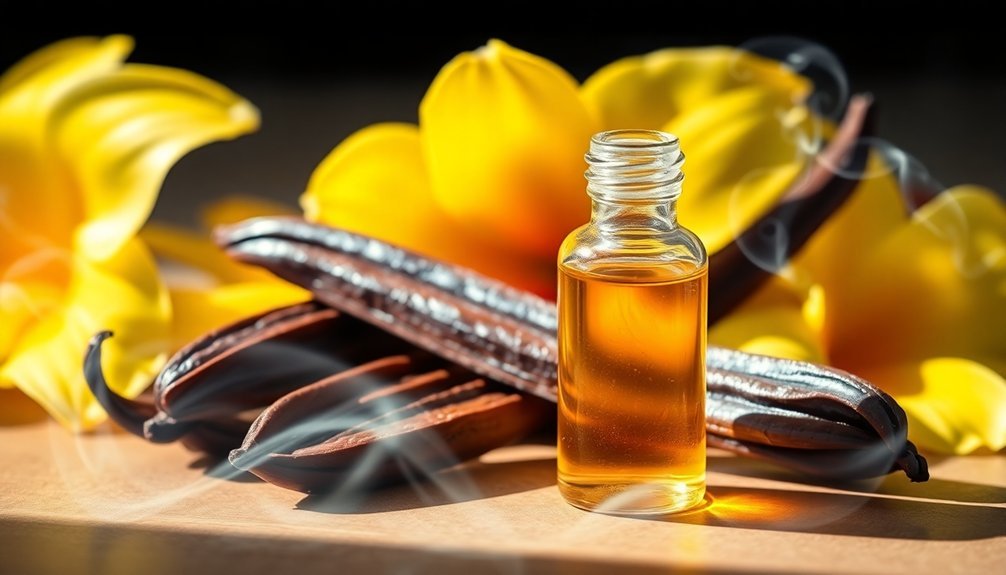
When two powerhouse fragrances come together, vanilla and ylang ylang create an enchanting symphony of scents that's greater than the sum of its parts.
You'll find vanilla's warm, sweet presence adds depth and luxury to any blend, while ylang ylang brings a soothing floral touch that calms and relaxes.
The magic lies in their complementary nature. Vanilla's rich base notes provide a sensual foundation that's perfectly balanced by ylang ylang's floral middle notes.
Like a dance between earth and air, vanilla anchors while ylang ylang's delicate florals take flight in perfect harmony.
While vanilla rarely stands alone in perfumery, it's enhanced by synthetic elements like vanillin, making it more intense and alluring.
Meanwhile, ylang ylang's natural aphrodisiac properties shine when properly paired, offering both emotional benefits and aromatic pleasure.
Together, they create a harmonious blend that's both comforting and mysteriously sensual. The vanilla component requires a carefully controlled tropical climate of 25°C for optimal cultivation and aromatic development.
Essential Ingredients for Your Sweet Blend
Creating a luxurious vanilla-ylang perfume requires carefully selected ingredients that work in harmony across different fragrance layers. You'll need to balance top notes for initial impact, middle notes for the heart of the fragrance, and base notes for lasting impression. For optimal calming effects, include the sweet exotic floral notes that make this blend so appealing.
| Layer | Key Components |
|---|---|
| Top | Bergamot, Green Tea, Lavender |
| Middle | Jasmine, Black Pepper, Orange Blossom |
| Base | Vanilla, Musk, Amber |
| Fixatives | Hyaluronic Acid, Glycerin |
| Enhancers | Xanthan Gum, Dimethicone |
For the best results, start with fresh citrus top notes like bergamot or lemon, then add floral middle notes of jasmine and orange blossom. Build your foundation with vanilla and musk, ensuring longevity with proper fixatives and enhancers. This combination creates a balanced, long-lasting fragrance that evolves beautifully on your skin.
Perfume Base Notes and Their Proportions

Base notes form the foundation of your vanilla-ylang perfume, serving as the long-lasting anchor that binds all fragrance elements together.
For this sweet blend, you'll want to use 5-20% base notes, depending on how long you'd like the scent to last. Vanilla, as your primary base note, provides a rich, warm undertone that can persist for six hours or more on your skin.
When mixing your base notes, you don't need to strictly follow traditional ratios. While the standard suggestion is 5-10% for a balanced scent, you can experiment with up to 20% if you're aiming for a more intense, longer-lasting fragrance.
Remember that base notes' heavier molecular structure means they'll continue to develop and deepen as you wear the perfume. Testing your perfume directly on your skin will help you determine if your base note ratios create the harmonious aroma you desire.
Mixing Your Signature Scent
As you commence on mixing your signature vanilla-ylang perfume, understanding the layering process will guarantee a well-balanced and harmonious blend.
Start by adding vanilla as your base note, which will provide the sweet, lasting foundation. Next, introduce ylang-ylang as your middle note, contributing depth and complexity to the fragrance.
For a fresh, vibrant touch, you'll want to incorporate a citrus top note like orange or grapefruit. Follow the common ratio of 20% top notes, 30% middle notes, and 50% base notes for ideal balance.
Don't forget to dilute your blend with perfumer's alcohol or carrier oil for safe skin application. Let your creation mature for several days, testing it periodically with fragrance strips.
Remember to document your formula, as you might want to adjust the proportions to perfect your signature scent.
Storing and Preserving Your Creation
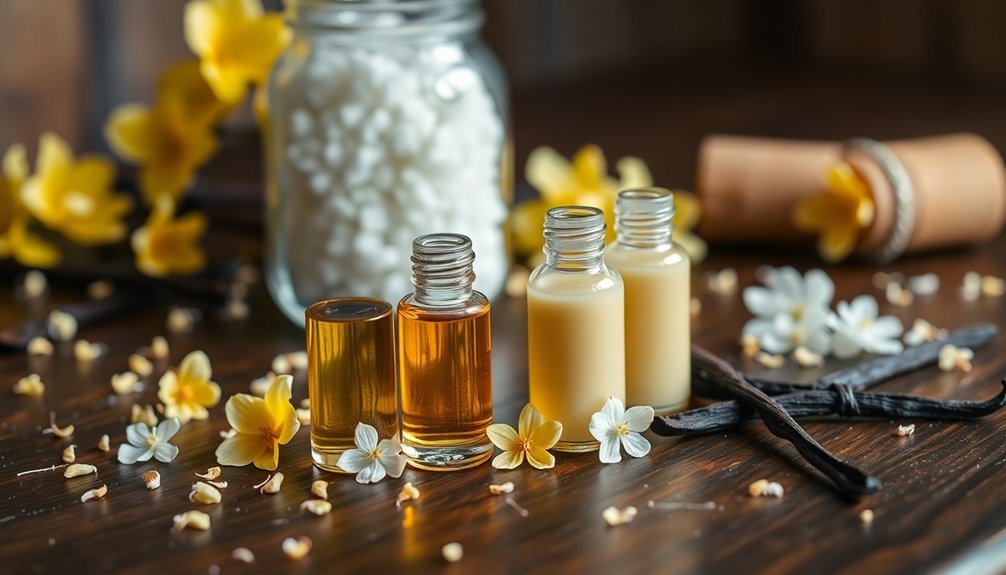
Now that you've crafted your signature vanilla-ylang perfume, proper storage will determine its longevity and scent quality. Keep your creation in its original bottle or an opalescent container to shield it from light damage. Find a cool, dark storage spot like a drawer or cupboard where temperatures stay around 60°F.
- Never leave your perfume exposed to direct sunlight or humid conditions.
- Keep the bottle tightly sealed when not in use to prevent oxidation.
- Avoid shaking the mixture, as this can disrupt the chemical structure.
- Check regularly for any signs of discoloration or unusual odors.
Don't decant your perfume into different containers, as this can introduce contaminants.
If you live in a humid climate, consider using a dehumidifier in your storage area to maintain ideal conditions.
The Art of Layering Fragrance Notes
The intricate art of layering fragrances transforms a simple scent into a complex, personalized signature.
When crafting your vanilla-ylang blend, start with a neutral base on clean skin to create the ideal canvas. Apply your vanilla base note first, allowing it to settle before adding ylang ylang as your middle note. You'll want to target your pulse points – wrists, neck, and behind ears – for maximum diffusion.
Remember that your skin chemistry plays a significant role in how the fragrances develop. Test small amounts first and wait to see how they interact.
If you're new to layering, begin with simple, single-note scents before experimenting with more complex combinations. The key is finding the right balance between the sweet depth of vanilla and the exotic floral notes of ylang ylang.
Choosing the Right Carrier Oils
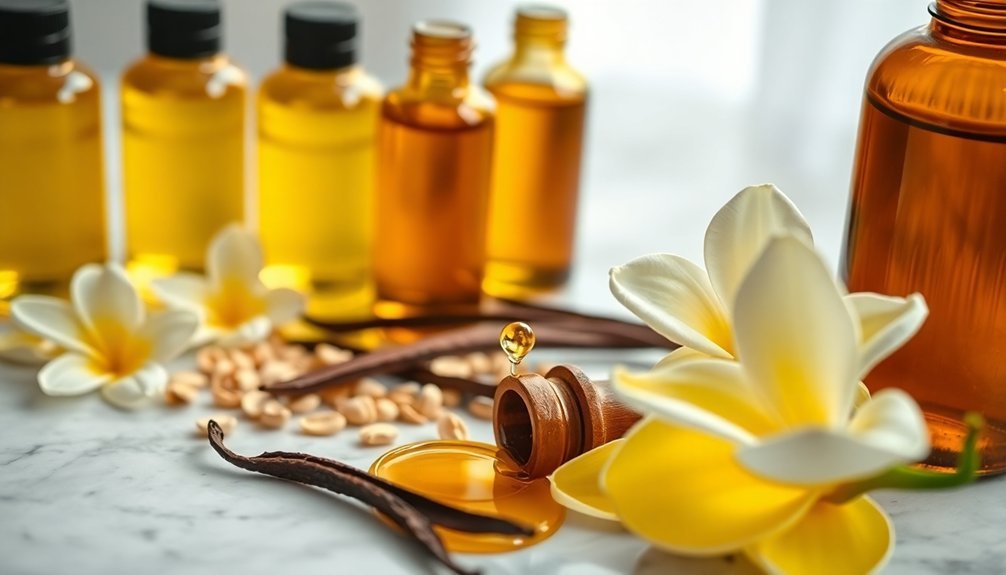
Building on your fragrance layering expertise, selecting appropriate carrier oils will elevate your vanilla-ylang blend to its full capacity. For your sweet vanilla-ylang perfume, you'll want to choose carrier oils that complement these warm, floral notes while ensuring proper absorption and longevity on your skin.
- Jojoba oil makes an excellent base due to its similarity to natural skin oils and ability to maintain fragrance.
- Sweet almond oil's light, nourishing properties enhance the vanilla's sweetness.
- Fractionated coconut oil provides a neutral foundation that won't compete with your ylang-ylang notes.
- Apricot kernel oil's silky texture helps create a luxurious blend while extending wear time.
Remember to test different ratios, starting with 15-30 drops of your essential oil blend per ounce of carrier oil, allowing the mixture to mature for maximum results.
Adding Complementary Floral Notes
Selecting the right complementary floral notes can transform your vanilla-ylang perfume from pleasant to extraordinary.
Start by adding jasmine to intensify the floral character while maintaining harmony with your vanilla-ylang base. You'll find that tuberose can deepen the sensual aspects of your blend, while classic additions like rose or carnation provide a timeless sophistication.
For a tropical twist, consider incorporating frangipani, which adds a bright, sunny dimension to your fragrance.
If you're seeking balance, try adding small amounts of lavender or geranium – they'll introduce a subtle herbal contrast that prevents the sweetness from becoming overwhelming.
Remember to add these florals gradually, testing as you go, since each note will interact differently with your vanilla-ylang foundation.
Fine-Tuning Your Sweet Perfume
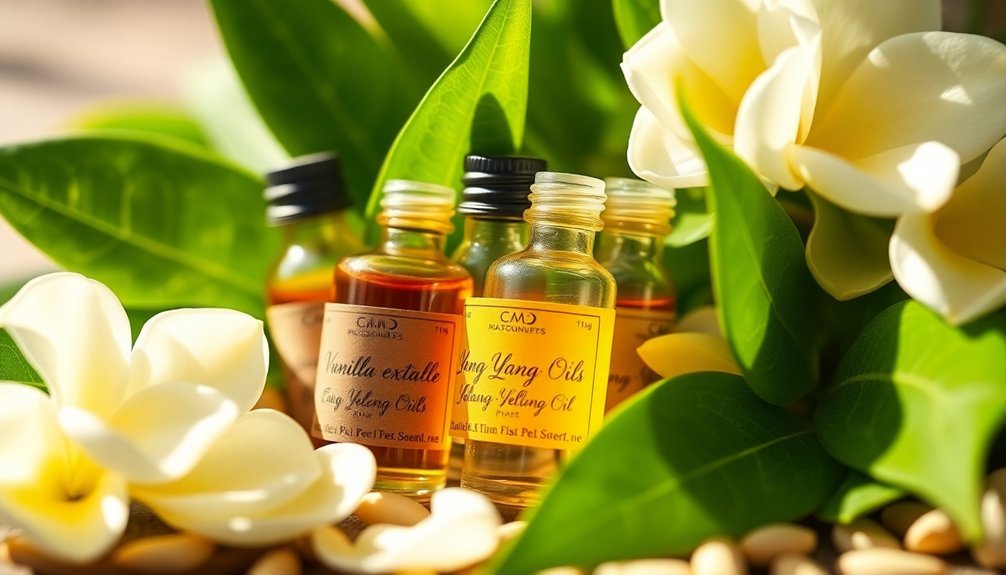
Once you've established your base composition, fine-tuning your sweet vanilla-ylang perfume requires careful attention to balance and proportion.
You'll want to adjust the fragrance by incorporating middle notes that enhance its warmth and complexity. Consider adding spicy elements or floral hearts while testing different ratios to achieve your desired scent profile.
- Add warming spices like cinnamon or black pepper to intensify the fragrance's depth
- Blend in stabilizing fixatives such as musk or sandalwood to extend longevity
- Experiment with floral middle notes like rose or lavender to support the ylang-ylang
- Adjust the carrier oil ratio to control the overall strength of your perfume
Remember to test each adjustment on your skin, as your natural chemistry will influence how the final fragrance develops and settles.
Application Tips and Techniques
To maximize the impact of your sweet vanilla-ylang perfume, proper application techniques make all the difference.
Apply your fragrance to pulse points, including your wrists, behind your earlobes, and the back of your knees, where body heat will help diffuse the scent throughout the day.
For best results, moisturize your skin with an unscented lotion before applying the perfume.
Don't rub the fragrance into your skin, as this breaks down the scent molecules. Instead, let it dry naturally.
You'll get better sillage by spraying from 6-8 inches away, and if you prefer a lighter touch, try the spray-and-walk method.
Apply your perfume right after showering when your skin is still warm, as this enhances absorption and longevity.
Enhancing Scent Longevity
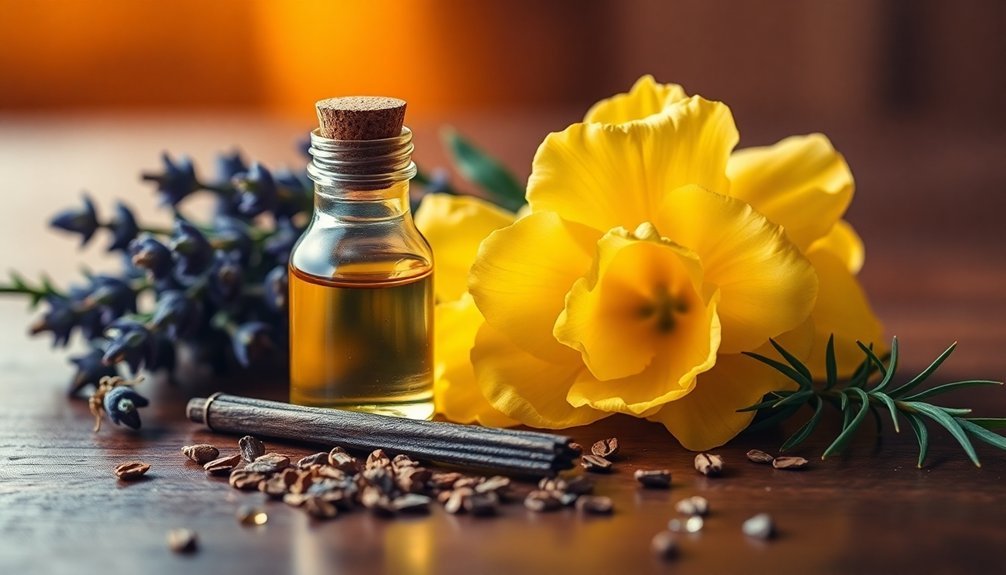
Whether you've crafted your vanilla-ylang perfume at home or invested in a premium blend, proper techniques can dramatically extend its staying power. Your fragrance's longevity depends on both proper application and storage methods. For maximum impact, start with moisturized skin and apply your perfume to pulse points without rubbing, allowing the scent to dry naturally.
- Store your vanilla-ylang blend in a cool, dark place to prevent fragrance degradation and maintain its sweet, exotic notes.
- Apply an unscented, oil-based moisturizer before spritzing to create an ideal foundation for the fragrance.
- Focus application on pulse points like wrists and neck, where natural body heat helps diffuse the scent throughout the day.
- Choose higher concentration formulations (Eau de Parfum) over lighter ones for extended wear time.
Seasonal Adaptations for Your Blend
As seasons shift throughout the year, your vanilla-ylang perfume blend needs thoughtful adjustments to maintain its ideal performance. You'll want to adapt your mixture to match both the weather conditions and seasonal moods.
| Season | Adjustment | Enhancement |
|---|---|---|
| Summer | Lighten vanilla | Add citrus notes |
| Fall | Increase ylang | Layer with oils |
| Winter | Deepen vanilla | Add warm spices |
In warmer months, reduce the vanilla concentration as heat amplifies its sweetness. When fall arrives, boost the ylang-ylang proportion and consider adding complementary oils for depth. During winter, intensify the vanilla notes and incorporate warming elements like cinnamon or nutmeg. Remember to layer your blend with a matching body lotion in colder months to extend its presence and create a more complex scent profile.
Natural Vs Synthetic Ingredients Guide
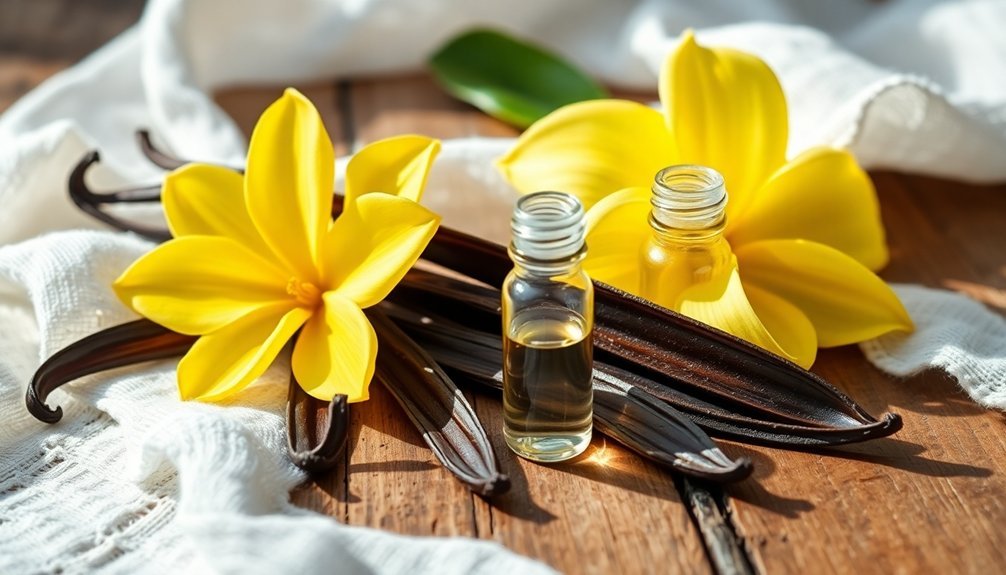
Making an informed choice between natural and synthetic ingredients presents a key decision point in crafting your vanilla-ylang perfume blend. While natural ingredients offer complexity and therapeutic benefits, synthetic components provide consistency and longevity.
You'll find that combining both can create a balanced, unique fragrance that captures the best of both worlds.
- Natural vanilla and ylang-ylang oils deliver rich, layered scents but may vary between batches
- Synthetic ingredients maintain scent stability and extend your perfume's shelf life
- A blend of both allows you to achieve consistent top notes while preserving natural depth
- You'll get better value by strategically using synthetics for certain notes while keeping premium natural ingredients for key character elements
Consider your priorities regarding authenticity, stability, and cost when selecting your ingredients.
Frequently Asked Questions
Can Pregnant Women Safely Use Vanilla and Ylang Ylang Perfumes?
You can safely use vanilla and ylang ylang perfumes during pregnancy, but you'll want to guarantee they're properly diluted with carrier oils and get your healthcare provider's approval before starting any aromatherapy routine.
How Long Does Homemade Vanilla-Ylang Perfume Typically Last Before Expiring?
Your homemade vanilla-ylang perfume typically lasts 1-2 years when stored properly. If you're using vodka as a base, it'll preserve better. Watch for changes in scent or color to detect expiration.
Will the Perfume Stain Light-Colored Clothing?
Yes, your perfume can stain light clothing due to its oils and synthetic components. You'll want to avoid direct contact with fabrics and instead apply it to your skin, especially pulse points.
Can This Perfume Trigger Allergic Reactions in People Sensitive to Bee Stings?
No, you don't need to worry about bee sting allergies with this perfume. While some people may be sensitive to fragrances, there's no connection between perfume allergies and bee sting reactions.
Does Altitude or Humidity Affect the Perfume's Scent Projection?
Yes, your perfume's projection will be stronger in humid conditions, as moisture enhances scent molecules. At higher altitudes, you'll need more sprays since thinner air reduces projection and longevity.

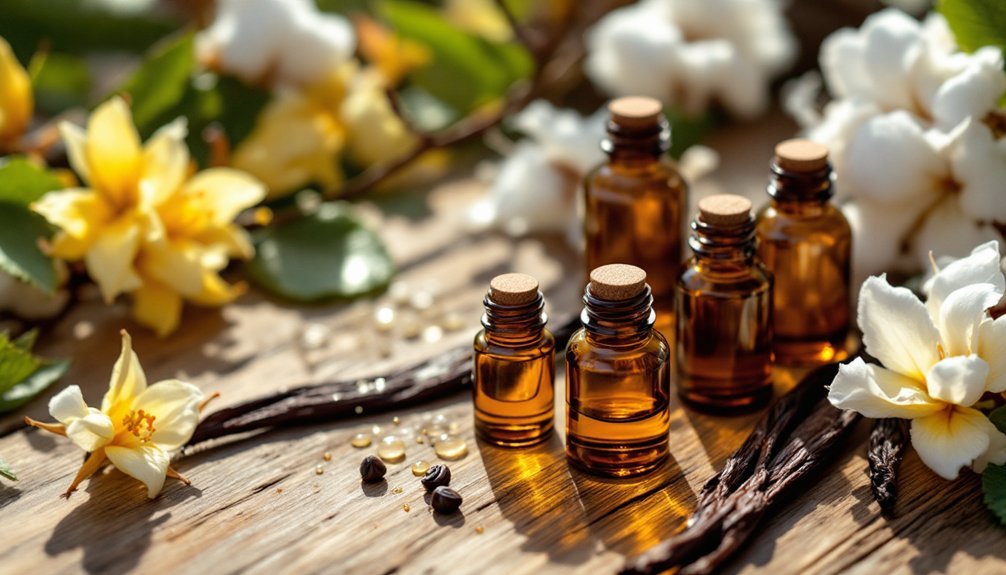



Leave a Reply